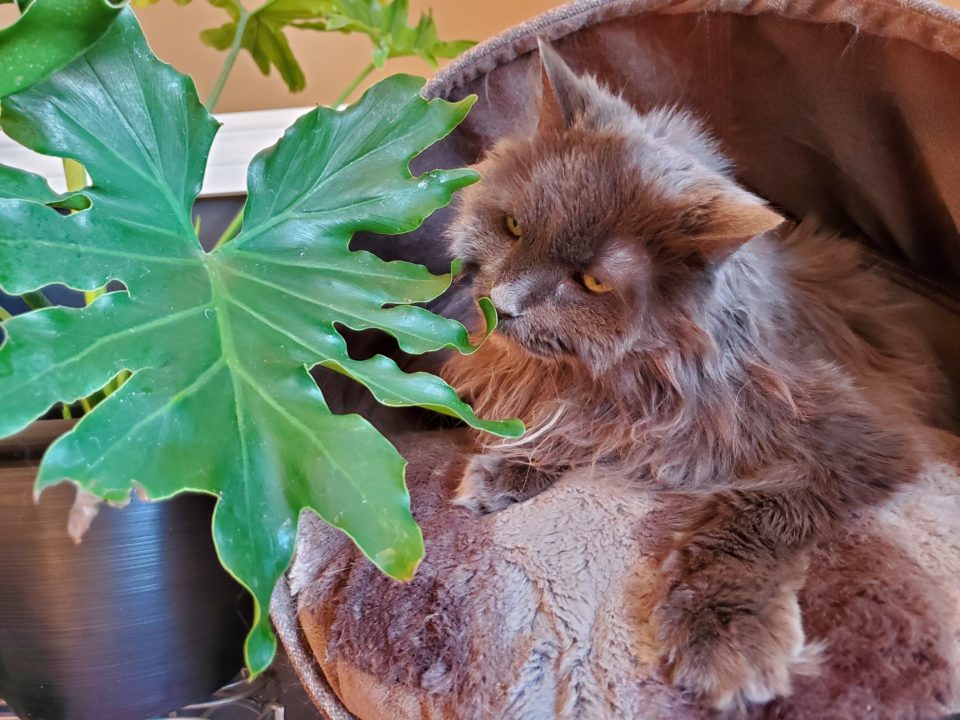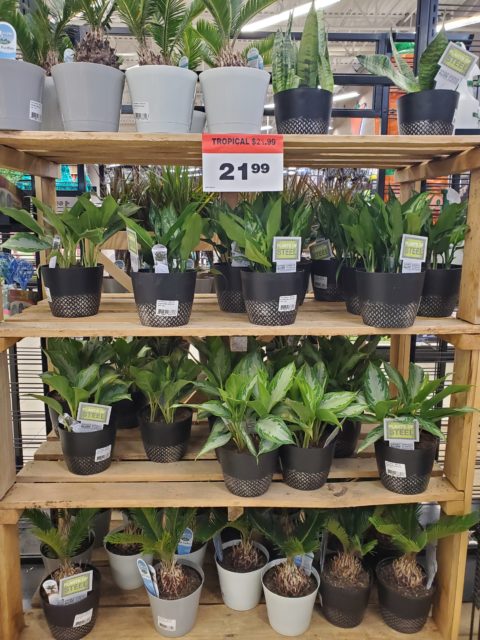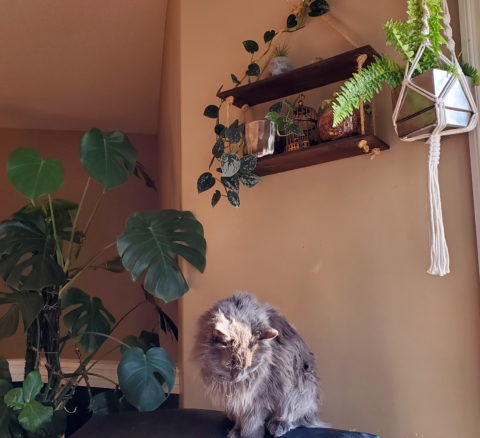
I have a serious love for animals. I mean, I should, right? I work in veterinary medicine. Another of my loves is houseplants. I have 2 dogs, a cat, and around 15 different houseplants, and they don’t always play nice with each other.
I’m fairly lucky that my dogs ignore my indoor collection (barely a collection in comparison to some) but that ignorance ends at the door to the backyard. However, this blog isn’t about outdoor plants so I won’t go into more detail. Just remember, plant toxicity doesn’t just apply to houseplants.
My cat is another story. She loves nibbling on whatever plants she can get to. I had seedlings on my bar height kitchen table that she never jumps onto. At least I thought she didn’t. Imagine my surprise when I woke to find them gone one morning. I came home from a weekend out of town to find puke all over my house and a very lethargic kitty. She had eaten some of my Peace Lily. That’s when I found out peace lilies are the number one toxin in cats in the US. Each of these encounters has forced me to up my plant-pet game.
First step: figuring out what could kill my pets. There are so many plants out there and almost none of them come with pet safety warnings. For this blog, I went to our local hardware store and took a picture of their houseplant display. The selection was basic; they only had 3 types of plants on the stand. Sago Palm, Chinese Evergreen, and Snake plants, all of which are toxic to pets. Of course, as veterinary professionals, we don’t recommend having houseplants that will cause death or severe disease in your pet. So do any of these 3 plants fall into that category?
The level of to xicity of each plant is different. Sago Palms/Cycad Palms are severely toxic, we’re talking death up to 75% of the time. Cats and dogs that ingest a small amount of any part of these these plants can experience vomiting, bloody stools, clotting issues, liver damage/failure, and, as mentioned, death. Yikes, maybe pass this one by if you have pets.
xicity of each plant is different. Sago Palms/Cycad Palms are severely toxic, we’re talking death up to 75% of the time. Cats and dogs that ingest a small amount of any part of these these plants can experience vomiting, bloody stools, clotting issues, liver damage/failure, and, as mentioned, death. Yikes, maybe pass this one by if you have pets.
Chinese Evergreens are moderately toxic for the same reason that Peace Lilies are, they contain insoluble calcium oxalates. Acting like small razor blades in your pets mouth, they can cause oral pain and swelling, excess drooling, pain when swallowing, and in severe cases, difficulty breathing which can require emergency treatment. Snake plants/Sansevieria (Also known as Mother-in-law’s tongue), Calla-lilies, elephants ear, philodendron, and umbrella plants are also in the same insoluble oxalate category. Who knew risk assessment would be a part of purchasing houseplants!
The next consideration: location. Where could I place my plant(s) that would prevent my pets from accessing them? I want to keep my pets safe, but I also want to ensure my plants are safe from my pets too! In my home, the answer to this question ties directly to the toxicity of the plant. For the most part, any level of toxicity would steer me towards putting the plant completely out of reach of my plant-hungry cat. A high plant stand, shelf, or room inaccessible to my pets would be my go-to choices in this case. This is also where I keep any plants that I would be heartbroken to find destroyed.

For mildly toxic or non-toxic plants that you want to protect from your pets, there are deterrents that you can purchase that would allow you to place those plants within reach of your pets but still prevent the plant’s destruction. One such deterrent is bitter sprays, such as Bitter Apple or Bitter Cherry. These products are meant to be sprayed onto surfaces that your pet is chewing on and make it taste abhorrent. Speaking from experience, this stuff tastes awful to people too! If you can, I would suggest taking the plant outside to spray it. At minimum, go easy on the spraying. You can thank me later.
Sometime a decoy plant can save the ones you want your cat to leave alone. Cat grass is safe and may help to satisfy your kitty’s insatiable plant appetite!
For some, the issue isn’t that their pets eat the plants but rather, they use the large pots as a litter box. A couple easy solutions exist for this issue! River rocks placed on top of the soil can not only stop unwanted pet eliminations, but they also look good. You can deter pets from jumping into the pot by loosely placing tin foil on top of the soil, or, if you like to crochet, there are clever crocheted pot covers that you can make.
With so many houseplants, how do you know which are toxic? How can you determine the level of toxicity? Which ones are safe? There are 2 websites that I love: ASPCA and Pet Poison Helpline. The ASPCA page has a comprehensive list of toxic vs non-toxic plants for cats and dogs. This is my overall favorite and is my go to when I am researching whether a plant is toxic. Pet Poison Helpline makes it easy to quickly assess toxicity level.
If you believe that your pet has consumed even a minuscule amount of a toxic plant, please call your veterinarian immediately.




